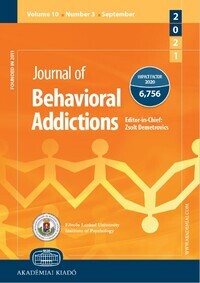Food addiction and lifetime alcohol and illicit drugs use in specific eating disorders
Food addiction and lifetime alcohol and illicit drugs use in specific eating disorders
Author(s): Romina Miranda-Olivos, Zaida Agüera, Roser Granero, Rhianna R. Vergeer, Carlos Dieguez, Susana Jiménez-Murcia, Ashley Gearhardt, Fernando Fernández-ArandaSubject(s): Behaviorism
Published by: Akadémiai Kiadó
Keywords: eating disorders; food addiction; impulsivity; personality; substance use
Summary/Abstract: Background and aims. Food addiction (FA) and substance use (SU) have frequently been reported in patients with eating disorders (EDs). Our study aimed to assess the prevalence rates of FA and/or lifetime problematic alcohol and illicit drug use among patients with specific ED, such as: bulimia nervosa (BN), binge eating disorder (BED), and other specified feeding and eating disorder (OSFED). We sought to identify clinical, psychopathological, and personality profiles involved in these addictive behavior-based phenotypes. Methods. The total sample was 527 patients (176 BN, 115 BED, and 236 OSFED). FA was assessed through the Yale Food Addiction Scale 2.0. To determine lifetime SU, a semi-structured clinical interview was carried out. Results. Patients with BN had the highest rates of FA both with and without SU. No gender differences were obtained for the prevalence of current FA and/or lifetime SU. Patients reporting at least one addictive-related behavior exhibited increased clinical severity compared to those who reported none. Increased impulsivity (such as high lack of premeditation, sensation seeking, and positive urgency) and low self-directedness were differentiating factors for presenting one or two addictive behaviors Discussion and Conclusions. Overall, patients presenting with at least one addictive-like behavior reported a poorer clinical status than those without. Also, patients with FA and SU exhibited a more dysfunctional profile characterized by high impulsivity and low self-directedness. These findings would support the need for targeted treatments to reduce impulsivity and increase self-directedness, especially in patients with any addictive-related behavior, as a step towards improving their treatment outcome.
Journal: Journal of Behavioral Addictions
- Issue Year: 11/2022
- Issue No: 1
- Page Range: 102-115
- Page Count: 14
- Language: English

